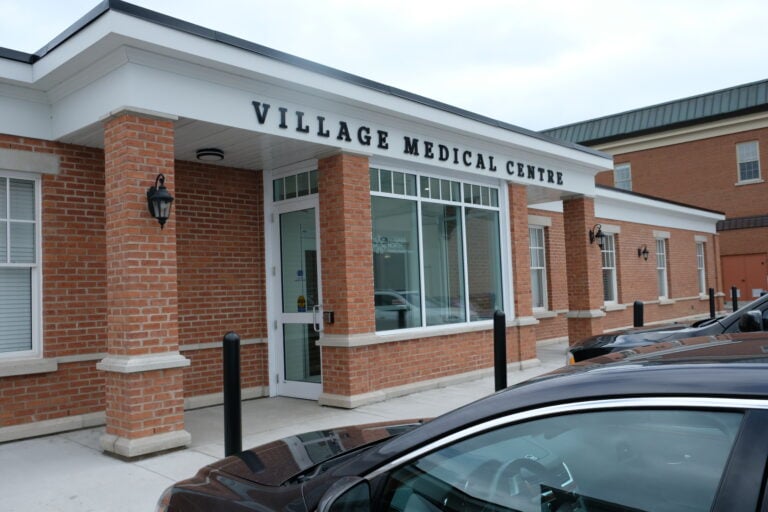Niagara's COVID-19 cases are starting to trend downward but we are probably a month away from safely winding down restrictions, says the region's chief medical officer of health.
Dr. Mustafa Hirji told a news conference Monday the falling case trend is positive, but warned that it will likely be until mid-June before cases are low enough to safely open again.
While case numbers are dropping, they're not declining as quickly as they rose, he said. “So it's going to take longer to get out of this than it did to get into it.”
Asked what the chances are the Ford government will listen to public health officials, Hirji said it's a better question for political pundits.
Most public health, science and hospital experts are recommending extending the stay-at-home order, he said. “All I can say is that, based on the science, the recommendation is actually that we need to extend” the latest shutdown.
Niagara's numbers are falling faster than the provincial average, he said, and overall there is strong evidence that vaccines are starting to play a role in reducing cases and severe illness.
Provincially, almost all COVID-19 cases are now variants, mainly the U.K.'s B.1.1.7 version, but there have also been confirmed cases of the Brazilian P.1 variant and the most recent B.1.617 variant, discovered in India, Hirji said.
“We know those variants spread more easily and because they spread more easily it's more difficult to control them and bring them down, particularly now that they are in such high numbers.”
He said while it's clear the P.1 variant is more severe, it's not certain if the B.1.617 variant is more deadly or more contagious. That variant exploded in India, but he noted it was about the same time India relaxed COVID-19 restrictions, so it's unclear if it was a result of a more serious strain, or due to opening too soon.
The World Health Organization declared B.1.617 as a variant of concern on Monday.
Hirji provided a chart to compare Canada to some other countries that have opened up at different paces. In all cases, the data showed all countries that opened up before cases were very low had a spike back into unmanageable numbers that put their health care system in jeopardy.
In Niagara, about 63 per cent of COVID cases are now variants, though he suspects that number is affected by a reporting delay and it is likely the “vast majority” of cases are now variants.
Another way to look at the data is the reproductive value of the virus, he said. If it's above one (meaning each person spreads the virus to more than one person) then numbers will go up. If it's below one, then numbers will decline.
“In mid-February when the province reopened, that allowed the reproductive number to go back up and stay up,” Hirji said, pointing to a chart of the reproductive numbers in Niagara.
With the lockdown in place, the number has gone below one and cases are starting to decline. On Monday the reproductive number was about 0.9 — more than the second lockdown, which saw the number dip down to 0.7, he said.
“You can see that this lockdown is not as effective at suppressing the growth, or suppressing cases the way that the second lockdown was, and I think that's again because of the variants.”
The “good news,” he said, is numbers are still going down, however it will take longer to get down to a safe level to reopen.
“We're almost halfway back down to this point. So that's certainly some good news but we, of course, need to stick this out for a few more weeks before we can get it down to a really low level, where hopefully we'll be able to contain it at that level,” Hirji said.
He is particularly worried about the P.1 variant because “in addition to spreading more easily, it is also more severe and that's definitely something we do not want to see continue to grow.”
He said provincial Science Table models show no matter how much cases are reduced, numbers will rebound once things reopen. It's just a matter of how steep the curve is. “The higher cases are, the higher they're able to rebound.”
If cases rise, it would mean hospitals continue to be overwhelmed and more people could die from the virus as a result.
Bringing down ICU numbers is an important part of being able to manage the virus, he said.
“The province had previously designated 150 people in ICU from COVID-19 was the danger level, but of course right now (we're) up closer to 900. So even if we've come down, optimistically, even to maybe 600 people by the end of the month, that's still extremely high,”he said.
“That's higher than we were between the first and the second wave and so I do think that we do need to keep the stay-at-home order a significantly longer time so we can continue to let this number come down. We can clear people out of the ICUs, get our hospital some relief, allow people to restart doing surgeries for cancer and some of those other important health issues.”
In Niagara, the number of hospitalizations has come down “a little bit,” Hirji said.
“And in ICU, the total number of people in the ICU remains fairly flat at this time.”
“Unfortunately we have definitely seen more deaths during this third wave, and of course that's ultimately why we're trying to control COVID-19, because if our hospital is overwhelmed that likely means people are going to be unfortunately dying and that's absolutely what we've seen,
“The good news is that as bad as this third wave has been and as much as it has stretched our hospitals more than ever before, we fortunately didn't see as many deaths as we did in the second wave,” he said. He credits vaccinations.
“But we have not vaccinated everybody, and a lot of people who are at lower risk of dying, but nonetheless at risk of dying, unfortunately have passed away during this third wave. That's absolutely why I think it's so important to get cases very low again, so we don't see people dying from COVID-19 and we're able to reopen in a fashion where we're able to keep cases controlled, that we don't see people unnecessarily dying in our society.”
As far as vaccinations go, he said about 56 per cent of people over 18 in Niagara have now been vaccinated.
One of public health's priorities is to target the 50 to 59 age group with messaging to encourage them to get the vaccine, he noted.
In a couple of weeks, anyone 18 and up will be eligible to book a vaccine, and shortly after that they will target people aged 12 to 17.
“So as we get more and more vaccinations in people, it'll hopefully be coinciding with us bringing cases down” and reopening carefully, he said.
In general, he said Canada as a country is starting to “catch up” with some of the countries that vaccinated people early.
Vaccines aren't bulletproof, he noted, comparing Canada to other countries with higher rates of vaccines, but that are doing worse in terms of case counts because they opened too soon, relying solely on the vaccines.
“Seychelles here is actually the number one country in terms of having vaccination penetration in their society, and they are actually doing the worst in terms of having cases really surge in their society. And the big lesson I think to take away from that is that relying on vaccination alone to control COVID is probably not something that's going to happen at least in the near term.”
Maybe it will be different once vaccination rates are “really high,” in the 80 to 90 per cent range, he said.
Seychelles opened to tourists and had a surge of cases, despite a high vaccination rate, he said.
Chile also opened up, had a surge of cases and “unfortunately they've had to use a lockdown now to bring their cases down.”
Cases in the United States have remained “pretty high” even though they've been “very successful with vaccination,” he said.
———————————– NOT EDITED BEYOND HERE —————
“The flip side here is the U.K. and Israel, which both in the latter part of 2020 saw various spiraling out of control in their societies, and actually went into quite intensive lockdown. The United Kingdom actually did a four month lockdown, three months in they reopened schools and wasn't until April 12 that they started to reopen the rest of society. Israel likewise had a pretty intense lockdown. In about early March they started to reopen. And the key thing you can see here is if you're looking at Israel, they brought the cases really low in kind of the early part of March before they reopened. And the benefit they saw as a once they were able to reopen them with cases really low, their high vaccination rate is allowed so far for those cases to remain really low and remain flat, and I think it was a lesson here is, do we want to copy the lessons of cases like the Seychelles and Chile, or do we do at the UK in Israel do, and I would very much argue we should do what the UK and Israel do — drive our cases really low so that when we reopen, we can actually do so safely, we'll have the vaccine really helping us, and we'll actually be able to make a much more confident return to normal.”
“Whereas if we reopen too early, if we don't extend the stay at home order that's expiring later this week, I think we could well be seeing something like the Seychelles, or something like Chile, where we see cases spiral up again, and despite our vaccinations, we'll be back to seeing our hospitals overwhelmed, and unfortunately going into a fourth lockdown, which is the last thing I think any of us need. And I think would be a huge unforced error because I think we've had the experience of what happens when we reopen too early after the second lockdown, so we don't want to make that same mistake again.”
Hirji said he is recommending the province to open about mid-June.
“Ultimately, how far it goes really needs to be dictated by conditions on the ground,” he said.
“Even in a very optimistic scenario of what we see with where cases are by the end of the month, we're still close to 1,000 cases … I still think that's pretty high so I would think that we probably need to extend it for another month into mid June, and then we can reassess, as we get closer to that date. And of course if things go well, cases come down more quickly than we realize, there's always the opportunity to pull that up earlier and end the stay-at-home order earlier. But my sense is that we probably need to go to mid June to see cases come down to a pretty low level, for our hospitals to really clear up, and by mid-June I think we'd also be closer to about 75 per cent of people being vaccinated, which is what the Public Health Agency of Canada has really articulated.”



.jpg)







